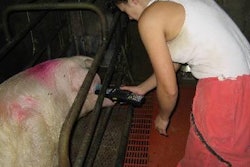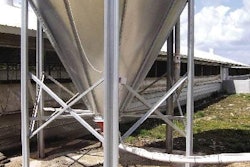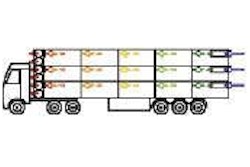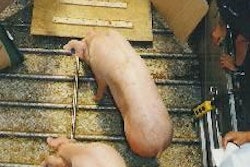.jpg?auto=format%2Ccompress&q=70&w=400)
Trucks with a distinctive SPF logo are a common sight on the roads of Denmark and northern Germany as they carry both piglets and seedstock pigs from Danish health-controlled production units. For the past 3 years, one of those pig transport vehicles has been equipped with a prototype robot washing arrangement to test the system's ability to save time and labour while still ensuring that all inside surfaces are 100% clean.
This installation is on a 2-deck trailer belonging to SPF-Danmark, which operates a fleet of 110 vehicles (including 20 with trailers) to transport some 10 million piglets and 350 000 breeding pigs domestically and internationally every year. The 60m² capacity of the prototype's trailer is large enough to hold about 400 piglets for journeys within Denmark.
Peter Skov Madsen, managing director of SPF-Danmark, recalls that the idea of robotic washing was first raised at an employees' meeting in 2003 after discussions had focused on the 2 hours or more needed to clean and disinfect a truck manually using a conventional high-pressure washer each time the transporter was unloaded. His suggestion of automating the process was thought crazy at first. The clean-up had followed the same high-labour routine for 25 years and no-one could imagine doing it any other way. But the group decided to try automation in one vehicle and this led to an approach to a Danish technology development company for help in designing possible equipment and controls.
Three years later, some aspects of the original design have been changed on the basis of experience. One of the lessons learned was that the many corners in a trailer are more difficult to reach and clean mechanically than might be assumed. Siting and adjustment of the robot's spray nozzles had to be altered to achieve the complete cleaning effect desired.
Robotic washing was always conceived as a push-button programme operating under remote control from a panel in the driver's cab. In their current form the buttons first initiate the application of a layer of soap across all inside surfaces to release the dirt before spraying starts. The spray is delivered at a high pressure of 150-180 bar through fine-mist directional nozzles on fixed arms. Pre-programming arranges longer application to the critical points those places known to need extra care in cleaning as spots which are hard to access and where grime can accumulate. Washing time also is extended after a long journey, on the basis that the inside of the truck will have become dirtier.
The next step is a visual inspection. Only after the driver has checked that the effects of the wash-down look correct does he push the button to start the final phase of disinfection, in which a solution of a low-pH peroxide disinfectant is applied through the same nozzles. A drying out phase completes the procedure.
Both hot and cold water have been tried. Obviously hot water works better, says Peter Skov Madsen, but it needs a heater and that is impracticable and costly. Testing has established anyway that cold-water washing is good enough. On each occasion after using the robot, SPF-Danmark has assessed whether the trailer looked visibly clean and also has taken samples from the interior for microscopic checking. Sampling uses a series of sticker pads placed at different parts of the vehicle and removed afterwards first for culturing at a room temperature of 37°C, then for examination of any microbial growth.
"We want the cleaned trailer to be sterile," Mr Skov Madsen declares, "even though we know that is extremely difficult to achieve. But the most important point in practice is that our checks have not found any micro-organisms that are pathogenic for pigs."
He calculates about 400 000 have been spent so far on developing the one prototype currently in existence. A Mark-2 version will probably be made in the next 1-2 years, he adds, to try out some proposed improvements. But the decision has been taken not to equip a series of pig transporters with washing robots until more information has been gathered.
"We know the robot we have now works faster than manual washing so it saves the driver's time," Peter Skov Madsen comments. "It has also met our target for vehicle cleanliness. However, we have said a payback period of 3-5 years would be needed before we installed robots for cleaning on all our trucks. There is still some way to go to achieve that."

















